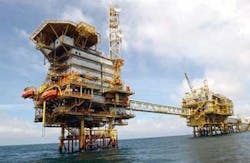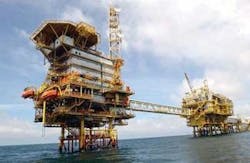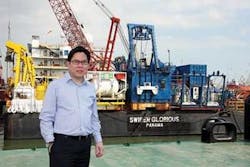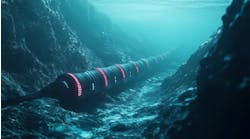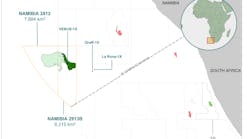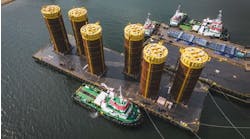Tracy Dulle, Technology Editor, Surface Systems & Vessels
State-owned and international oil companies in Asia continue to increase E&P spending.
The global market for offshore operations, currently estimated at $136 billion, is expected to hit $159 billion by 2010, according to Fusion Consulting. Asia-Pacific’s market share of 23% is set to rise from $31 billion now to $41 billion by 2010, at an annual growth rate of 8%, the group says.
Energy analyst Infield Systems says Asia is one of the fastest growing regions in oil and gas production. Infield forecasts development capex to rise 91% over the next five years, with 53% of expenditure concentrated in Indonesia, India, and Malaysia.
Oil companies agree that the region is certain to grow.
“The Asia-Pacific region is poised to become the world’s most significant oil and gas consumer, with demand forecasted to grow by about 90% by 2030,” says Jim Blackwell, president of Chevron Asia-Pacific Exploration and Production Co.
China
China National Offshore Oil Corp.’s (CNOOC) total targeted net oil production in 2008 is 195-199 MMboe. This compares to net production for 2007 of an estimated 169-171 MMboe, and represents a 13-14% increase.
CNOOC has 10 new projects expected to come onstream this year, including major projects offshore China in the Penglai 19-3 Phase II, Wenchang oilfields, and Xijiang 23-1.
CNOOC’s Bo Zhong (BZ) 34-1 oil field in Bohai Bay in northeastern China came onstream early this year, two months ahead of schedule. More than 4,800 b/d of oil are currently being produced from seven wells.
According to the ocean drilling program plan, there are more than 20 producing wells in BZ34-1, and other wells will come onstream in 2008. The peak production of the field is expected to reach 12,000 b/d of oil.
Roc Oil (China) Co. drilled two exploration wells in offshore China in 1Q 2008.
In the Zhao Dong C&D oil fields and C4 oil field, Bohai Bay, offshore China, the 2008 drilling program will comprise of up to a total of 24 wells with a mix of oil producers and water injectors.
Vietnam/Thailand
Final investment decision for the South Bongkot field in the Gulf of Thailand is expected by mid-year. It is expected to become one of the largest developments aimed at meeting Thailand’s energy demand.
Bongkot South, predicted to cost over $1 billion, would take about three years to develop, according to industry estimates.
Front-end engineering and design for the project in the Gulf of Thailand has been completed, making it the third largest development after Bongkot field and the billion-dollar Arthit project (see related story on page 78).
Meanwhile, Chevron signed an agreement in 2007 to extend the production period of four offshore blocks in the Gulf of Thailand by 10 years. Construction of a second natural gas processing plant in the Platong area also is planned for Thailand, Chevron said.
Early this year, Thai authorities awarded Pearl Energy Ltd. a petroleum contract for block G2/50 in the Gulf of Thailand. Block G2/50, held 100% by Pearl Oil (Petroleum) Ltd., covers 1,126 sq km (435 sq mi) adjacent to concession area B5/27, where Pearl operates the producing Jasmine oil field.
SOCO International also has been busy in Asia. First production from the Bualuang field in Western basin off Thailand is expected during 2Q 2008, SOCO said.
SOCO’s Ca Ngu Vang field on block 9-2 in Cuu Long basin offshore southeast Vietnam is projected to come onstream mid-year. The company is confident that the Te Giac Trang field on block 16-1 will be declared commercial before the end of the first half of 2008. This follows an extension by the Vietnam government of the block 16-1 exploration license that will allow SOCO to add to the existing discoveries or progressing the already significant field discoveries toward first oil through June 6, 2008.
Talisman’s Hai Su Den exploration well in block 15-02/01 offshore Vietnam, was successful and tested at combined rates of over 21,000 boe/d. Two new exploration wells at Hai Su Bac and Hai Su Nau will start drilling shortly, the company said in early March.
This is Talisman’s second oil discovery in Vietnam in the past year, following the Hai Su Trang (HST) Miocene sandstone discovery on the same offshore block.
The five-well development drilling program in the Song Doc field in block 46/02 is complete and first oil is expected in 3Q 2008, Talisman said.
The company said exploration and development spending in Southeast Asia is expected to be $748 million in 2008, with plans to participate in up to 23 exploration and 59 development wells.
Indonesia/The Phillipines/Malaysia
In Indonesia, Chevron is expanding the North Duri development, already one of the largest steamflood projects in the world, and is pursuing large deepwater gas developments.
Talisman will continue to progress development of its large gas reserves in the Corridor block off Indonesia, with sales to West Java expected to increase throughout 2008. In addition, Talisman will acquire seismic data in advance of deepwater exploration drilling planned for late 2009.
Baronia field in the Sarawak basin on Malaysia’s continental shelf. Photo courtesy of Petronas.
Meanwhile, the Makassar Strait Explorers Consortium will begin drilling the Karama block off west Sulawesi in Indonesia’s Makassar Strait in late 2009.
The consortium’s drilling program includes a total of 12 exploration wells during a two-year period. Marathon is acting as lead operator for the group, but each consortium member is responsible for its own committed wells.
Perth-based Nido Petroleum is seeking an oil major to farm-in to its 100% held deepwater concessions in the NW Palawan basin in the Philippines.
The company has identified 20 new leads in the basin’s Service Contract 54, 58, and 63, covering some 3 million hectares (7.4 million acres) of offshore area after completing an extensive 3D survey last year.
The next move is to secure a strategic partner to execute a statistically significant exploration program, expected in the last half of 3Q 2008, Nido says.
The company also was preparing to produce oil from the Galoc 3 and Galoc 4 wells in the basin from April, earnings from which would finance the extensive exploration program.
Galoc 3 is set to produce 5,397 b/d of oil and Galoc 4 – 6,565 b/d. The wells now are ready for production with an FPSO vessel due onsite and subsea installation in place.
In the Commercial Arrangement Area between Malaysia and Vietnam (PM-3 CAA), Talisman has a major development project under way in the Northern fields, with first gas sales expected by mid-2008 and oil production early in 2009. Development drilling started on schedule in late-2007 and a number of platforms and other major pieces of equipment installed during the fourth quarter.
Malaysia’s Petronas Carigali Sdn Bhd plans to drill 80 wells this year – 36 of which will be exploration wells and 44 development. Petronas is operating 468 oil wells, 697 artificial lift wells, and 264 gas wells.
Its projects include a wide range of fields, among the most recent is the Gumusut-Kakap deepwater field, a second multi-billion dollar development after the Kikeh, which began production last year. Gumusut-Kakap is a combination of two fields in a single development under a Unitization and Unit Operating Agreement signed by the co-venturers Sabah Shell Petroleum Co. and ConocoPhillips Sabah Ltd. Shell and ConocoPhillips each holds 33% stake in the field.
Shell will be operator of the development, which will employ the region’s first deepwater floating production system (FPS), with a processing capacity of 150,000 b/d of oil.
The field, in 1,200 m (3,937 ft) of water in blocks J and K, will be developed using 19 subsea wells with oil exported via a pipeline to a new oil and gas terminal, which will be built in Kimanis in the east Malaysian state of Sabah.
Lundin Malaysia BV has signed three new production-sharing contracts (PSCs) with Petronas. The PSCs cover blocks PM308A and PM308B in the Penyu basin offshore Peninsular Malaysia and block SB303, offshore Sabah.
PM308A and PM308B cover about 5,500 and 8,600 sq km (2,124 and 3,320 sq mi), respectively. PM308A contains one oil discovery, the Rhu field. Several prospects and leads have been identified in the blocks from previous 2D and 3D seismic campaigns.
India
In India, the Ministry of Petroleum and Natural Gas is considering a new policy to extend the exploration period for hydrocarbon prospecting in deepwaters, especially considering the tight supply of new rigs. The Ministry said the policy would help companies’ complete their exploration commitments, which currently are for eight years, with first phase of five years and the second phase of three years. The Ministry expects the policy to be in place in about one year.
The Ministry, through its directorate general of hydrocarbons, is preparing to award more deepwater blocks later this year under the National Exploration Licensing Policy VII round.
In February, Oil and Natural Gas Corp. Ltd. (ONGC) of India announced an offshore discovery in well B-12-11 in PEL block BOFF 1,2,3 in the Arabian Sea.
Meanwhile, Ramunia International Services Ltd. and Ramunia Fabricators Sdn Bhd have secured a $685-million contract from ONGC for the B-193 field development. Ramunia Group expects to complete the project by 2010.
The B-193 cluster field is in the Heera-Panna-Bassein block of Bombay offshore basin, about 60-90 km (37-56 mi) west of Mumbai in water depths from 60-75 m (197-246 ft).
Australia
The degree of interest in exploration offshore Australia can be gauged by the degree of interest in new offshore leases. In 3Q 2007, Australia awarded 11 new offshore permits out of 21 bids with the winning bid promising to spend a total of $800 million in exploration activities.
Woodside Petroleum Ltd. expects first oil from the $720-million (Woodside share $432 million) Vincent oil project in 2008 with initial output of 100,000 b/d.
Woodside said it has hedged some production to more effectively manage the economic risk associated with the Vincent project, which was approved in March 2006. Woodside also said it signed a heads of agreement with Japan’s Kansai Electric Power Co. for the supply of 1.75 to 2 million metric tons (1.9 to 2.2 million tons) of LNG a year over 15 years from the Pluto LNG project offshore Western Australia.
After updated interpretations from Pluto-3 and Pluto-4 well appraisal information, the current best estimate dry gas contingent resource (excluding inerts, no allowance for future fuel and flare) was increased to 4.1 tcf, an increase of 14% over the previously reported 3.6 tcf.
Woodside Petroleum earlier this year awarded a $100-million contract to a J. Ray McDermott S.A. subsidiary for the Pluto offshore platform northwest of Karratha, Western Australia. The scope of work includes the installation engineering, transportation, and installation of the complete platform.
The substructure, a four-leg extended base tower with a launch weight of 10,000 metric tons (11,023 tons), will be secured with drilled and grouted foundations by J. Ray’s 3,080-ton (2,794-metric ton) capacity construction barge, theDB30. The barge also will lift and install the topsides. Work is expected to be completed 4Q 2009.
The Pluto gas field was discovered in April 2005 in the Carnarvon basin. The field is 190 km (118 mi) northwest of Karratha. Woodside also has awarded a $150-million contract to Acergy SA for offshore installation work at Pluto. The contract covers installation of subsea manifolds, value structures, umbilicals, MEG injection line, and pipeline stabilization, plus flowline tie-in at water depths to 850 m (2,789 ft). Engineering is under way, and installation byToisa Proteus is scheduled in the latter half of 2009.
MEO Australia Ltd. made a discovery off Australia’s northwest coast in early March.
Seadrill’s jackupWest Atlas has completed a series of logging runs, including the recovery of hydrocarbons to surface by modular dynamics testing (MDT) downhole sampling. Additionally, a number of core samples through the column have been obtained.
Apache Corp. continues to make headway with its 2008 exploration program. Apache now has drilled five gas discoveries on license WA-356-P, including Julimar-1, Julimar East-1, Brunello-1, and Brulimar-1.
Apache is planning to drill 52 wells, including 32 exploration wells, in Australia in 2008.
The latest discovery, the Julimar Southeast-1 discovery on Australia’s Northwest Shelf, logged 195 ft (59 m) of net pay across five intervals of the Triassic Mungaroo Sandstone, Apache says.
Apache and Santos are partners in the Reindeer Gas Project in the Carnarvon basin, offshore Western Australia. First gas is targeted by the end of 2010, Santos says.
Reindeer will be produced via an unmanned, minimum facility wellhead platform in 65 m (213 ft) of water. Gas and liquids will be exported from the platform to a new onshore gas processing plant via a single 105-km (65-mi) pipeline. The processing plant, to be at Devil Creek, will have a capacity of 215 Tj/day (gross) and will deliver sales gas and stabilized condensate. Sales gas will be compressed and exported to the Western Australian domestic market via the Dampier-Bunbury Natural Gas Pipeline.
The Northwest Shelf’s $5-billion North Rankin Gas Compression project to recover remaining lower pressure gas from the North Rankin and Perseus gas fields is under way.
The project comprises a new gas compression platform, North Rankin B (NRB), to be constructed adjacent to the existing North Rankin A platform, which will require significant brownfield work including the installation of new equipment. The two platforms will be connected by a 100-m (328-ft) bridge and will operate as a single facility.
It is expected to start-up in 2012, with steady state production scheduled for early 2013.
North Rankin is in 125 m (410 ft) of water, approximately 135 km (80 mi) offshore Karratha on the northwest coast of Western Australia.
Fugro-Geoteam’sGeo Atlantic has acquired 1,400 sq km (541 sq mi) of 3D seismic data in WA-398-P of Browse basin offshore northwestern Australia. The data is being processed with the aim to establish a drilling site for 3Q 2008.
Hydrocarbon reserves in Nexus Energy Ltd.’s Crux field in the Browse basin have increased following the successful drilling of the Crux-3 and Crux-4 appraisal wells, the company reported in March.
The Crux-4 well was suspended successfully as a future production well for the Crux liquids project. It is the third appraisal well to be retained as a future development well. Four additional development wells are planned for the Crux liquids project.
Meanwhile, CGGVeritas’M/V Pacific Titan is acquiring 530 km (329 mi) of full-fold seismic data in the Molson 2D Marine Seismic Survey, which began in March.
The survey for Tap Oil Ltd. is in the Bass basin between Victoria and Tasmania and is part of Tap’s assessment of the T/47P area, which includes the 2007 3D Labatt seismic survey.
Both of these surveys will be used for prospect definition leading to the planned two well program planned for 2009. Rig slots have been secured in preparation for this program.
Roc Oil’s Cliff’s Head oil field achieved its production target of 3 MMbbl in 2007, its first year of production, and in November 2007, 18 months after production began, the field produced its 5 millionth barrel of oil and paid out its $327 million capital cost. As far as 2008 plans, the company says a three-well exploration/appraisal program is in progress in the offshore Perth basin.
New Zealand
The Kupe Gas Project plans exploration drilling of the Momoho prospect in the Kupe permit area, 6 km (3.7 mi) south of the Kupe gas field, in the Tasman Sea, offshore New Zealand.
Momoho 1 will target a complex structural high situated between the Kupe South 4 non-commercial gas discovery, 2.5 km (1.6 mi) to the northwest and the Kupe South 5 non-commercial oil discovery, 1.2 km (0.7 mi) to the southeast.
The well is planned to a TD of 3,150 m (10,335 ft) with primary reservoir targets in both the Farewell and Puponga formations. The Farewell formation, the main hydrocarbon bearing zone at the Kupe field, is expected to be intersected at a depth of approximately 2,850 m (9,350 ft).
If Momoho is commercial, a development may be able to connect to the Kupe platform. •
New design semi to serve SE Asia market
Swiber Holdings Ltd. is building a specially designed deepwater drilling barge for the Southeast Asian and Indian upstream sectors, which is expected to attract 10% of the $25 billion global deepwater investment through to 2012.
Swiber executive chairman and CEO Raymond Goh said the rig, to be calledEquatorial Driller, is his company’s latest solution for efficient deepwater drilling in mild waters.
Goh has short listed a shipyard to build the barge-based rig by 2010, and has secured all lead-time equipment contracts with international suppliers.
Swiber also is expanding its fleet of barges, boats, and rigs through to 2010. It is adding three utility/towing boats and two anchor-handling tugs (AHTs) this year, taking the fleet to 28 units. Four more AHTs will be added next year and two subsea support vessels will be put in service by 2010.
Furthermore, Swiber is building two pipelay barges this year and one next year, while three accommodation barges will join the fleet this year for servicing the Asian offshore sector. A second crane barge will be added next year, Goh says.
The company plans to expand the fleet to 47 by 2010 from 28 in 2007 in response to the market demand.
null
